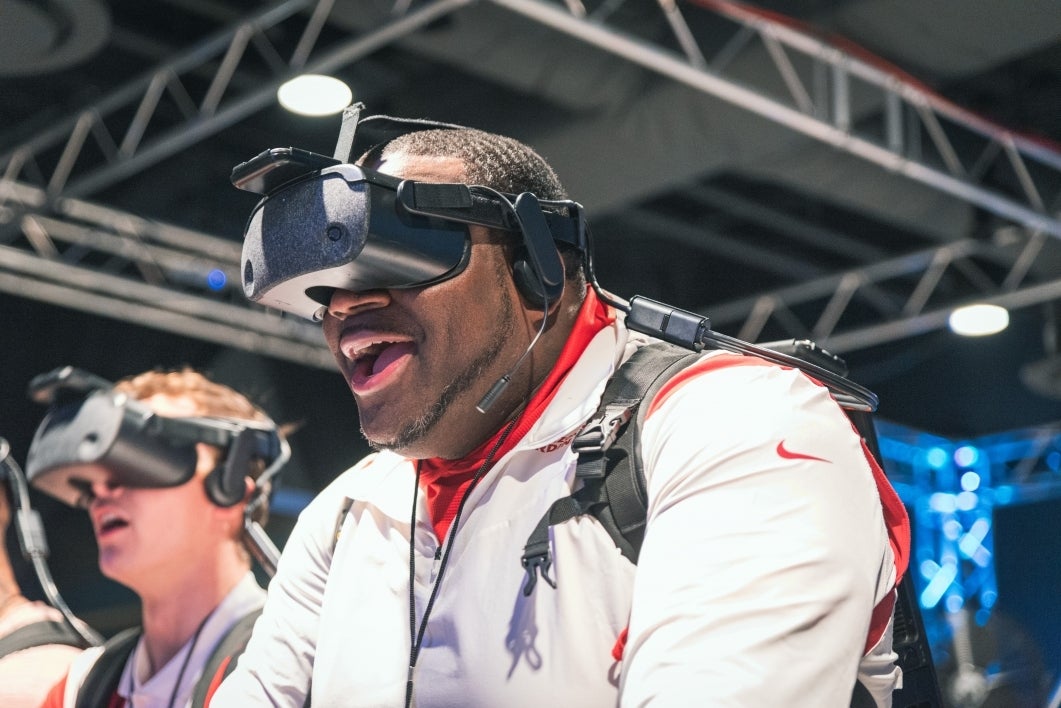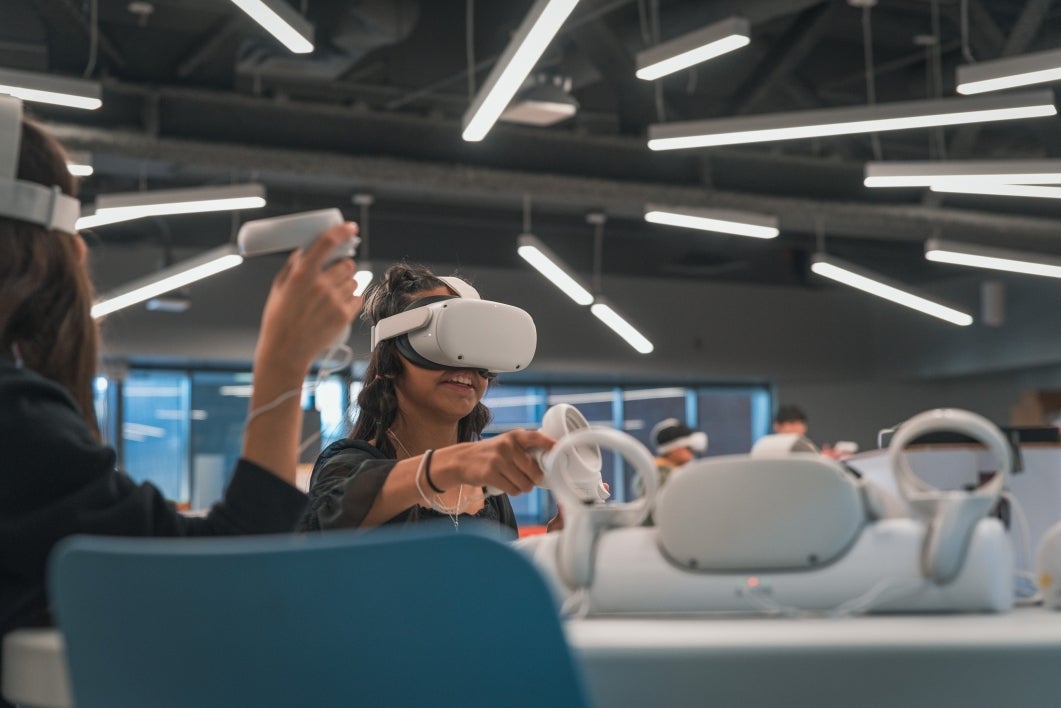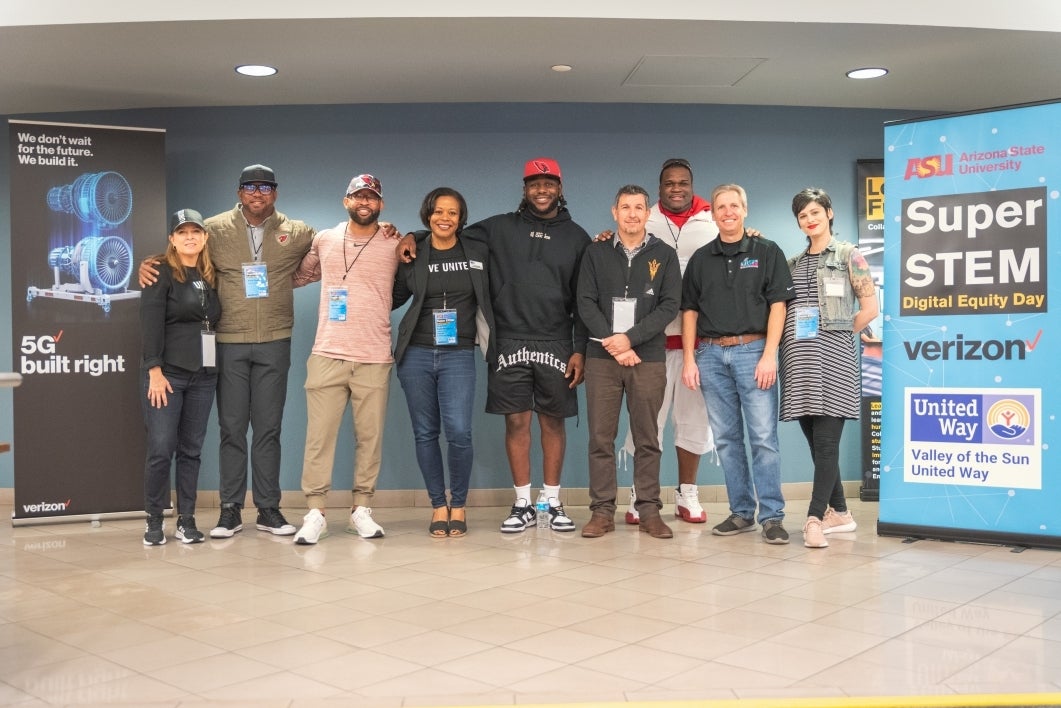Local elementary students connect with Cardinals players for a day of STEM at ASU

Part of the experience for Super STEM Day at ASU included Dreamscape Learn, a first-of-its-kind lab that blends cinematic storytelling, cutting-edge immersive technologies and advanced pedagogy to create educational virtual experiences. Photo by Mike Sanchez/ASU Enterprise Technology
Strap on a headset, slip on hand controls and become fully immersed in new worlds and virtual experiences. From exploring fictional alien zoos to virtual Mars expeditions, teams at Arizona State Univeristy's Learning Futures and Dreamscape Learn are designing and developing highly immersive, virtual reality (VR) experiences to expand beyond the boundaries of today’s digital landscape.
And on Thursday, Feb. 9, these teams welcomed over 75 local sixth-grade students to the Tempe campus for Super STEM Digital Equity Day to explore game design, immersive storytelling and immersive learning through various hands-on activities.
“This is a unique opportunity for our students to experience different parts of STEM learning in a way that many of these students wouldn’t otherwise get to experience,” said Carrie Heightsman, a sixth-grade language arts teacher at Sevilla West Elementary School. “And to actually be on a college campus makes the path to college real because some of these students would be first-generation college students in their family.” The school is part of the Verizon Innovative Learning program, which supported the event.
Also, in celebration of the Super Bowl, which took place in Glendale on Sunday, Feb. 12, the ASU teams welcomed Frank Sanders, Michael Pittman Sr., Ben Patrick and Jesse Luketa of the Arizona Cardinals to join students throughout the event.
“The exposure these kids are getting to new technology at their ages is amazing,” said Patrick, former Arizona Cardinals tight end. “I wish I had something like a Super STEM event when I was growing up. It's really cool to see them interacting in these immersive experiences this early in their academic journey."
With a focus on exposing the students to various opportunities in STEM, they learned about the technology used to create experiences in VR and game design. Then, they were tasked to apply the computer science principles learned to create their own obstacle course on a virtual Sun Devil Stadium through Roblox Studio.
Bridging the digital and educational divide
Less than half of K–12 students in the U.S. have proficient math and science scores. This is largely attributed to educational barriers disproportionately affecting urban and rural communities where students often lack access to adequate internet and educational resources.
“So much of this technology can feel exclusive to those with a technology background or greater means of access,” said Olivia Hernández, who organized the event and is the creative manager at Learning Futures, part of ASU Enterprise Technology. “And what I love about this event is that we're able to first and foremost showcase how this tech supports experiences and how learners can communicate art, design and storytelling through emerging technology.”
During the Super STEM Day event, students broke out into cohorts to work through three activities in VR and game design.
The first cohort started with a game-design activity using Roblox Studio in which students virtually built an obstacle course on Sun Devil Stadium for their avatar to navigate. The obstacle courses students designed included everything from rainbow staircases to raging fire pits and everything in between.
“Once they figured out the control, they just went crazy with it,” said Jesse Murdock, a digital twin specialist at Learning Futures. “Throughout the activity, they started to collaborate and learn from each other to build these obstacle courses, which was really exciting to see.”
The next two experiences demonstrated STEM applications in VR.
Up first was Dreamscape Learn, a first-of-its-kind lab that blends together cinematic storytelling, cutting-edge immersive technologies and advanced pedagogy to create educational virtual reality experiences. Dreamscape Learn is led by teams at ASU's EdPlus and Enterprise Technology.
With backpacks, headsets and hand and foot controllers, the experience is fully immersive. For example, students entered a virtual zoo where they treated fictional, alien-like dinosaurs in a fully immersive environment to learn introductory biology concepts.
“One thing that we try to communicate through immersive, interactive experiences at Dreamscape Learn is that anyone can do this,” said Stefanie Franco, a program coordinator from EdPlus. “Today our learners were able to experience a potential future as scientists, and these experiences could catalyze action toward that newly envisioned future for themselves.”
Following their virtual expeditions in Dreamscape Learn, students gathered in small groups of five around a table for another VR experience called Huddle, created by a team of student developers at Learning Futures.
Donning Oculus headsets and hand controllers, students were transformed into avatars and immersed themselves into one of two virtual reality environments: a football-themed virtual reality space, equipped with helmets and first-aid kits, or a space-themed laboratory with an entryway to the rocky, desolate terrain of Mars.
“We want to see them having fun in these spaces, but I think it's also really important they see a roadmap forward into a college career as future developers,” said Toby Vaughn Kidd, director of studios at Learning Futures. “Because everything we’ve created at Learning Futures came from college students who started just like them.”
With support from Verizon and Valley of the Sun United Way, the event brought together a wide range of technology leaders from across the ASU community for a fun-filled day of STEM knowledge-building to fuel further creativity and collaboration in and out of the classroom.
In the future, Learning Futures plans to host more events like Super STEM Day for learners to explore ASU campuses and earn industry-grade STEM certificates in the process.
“It’s these types of events when we're able to open our doors and provide students with access to meaningful, collaborative experiences that fulfill our purpose as an academic institution,” Hernández said. “Because it’s about who we include rather than who we exclude that allows us to make a difference in STEM fields.”
More Science and technology

4 ASU researchers named senior members of the National Academy of Inventors
The National Academy of Inventors recently named four Arizona State University researchers as senior members to the prestigious…

Transforming Arizona’s highways for a smoother drive
Imagine you’re driving down a smooth stretch of road. Your tires have firm traction. There are no potholes you need to swerve to…

The Sun Devil who revolutionized kitty litter
If you have a cat, there’s a good chance you’re benefiting from the work of an Arizona State University alumna. In honor of…





